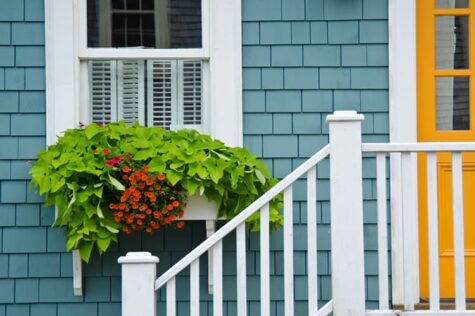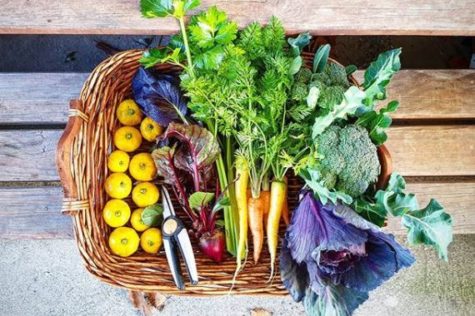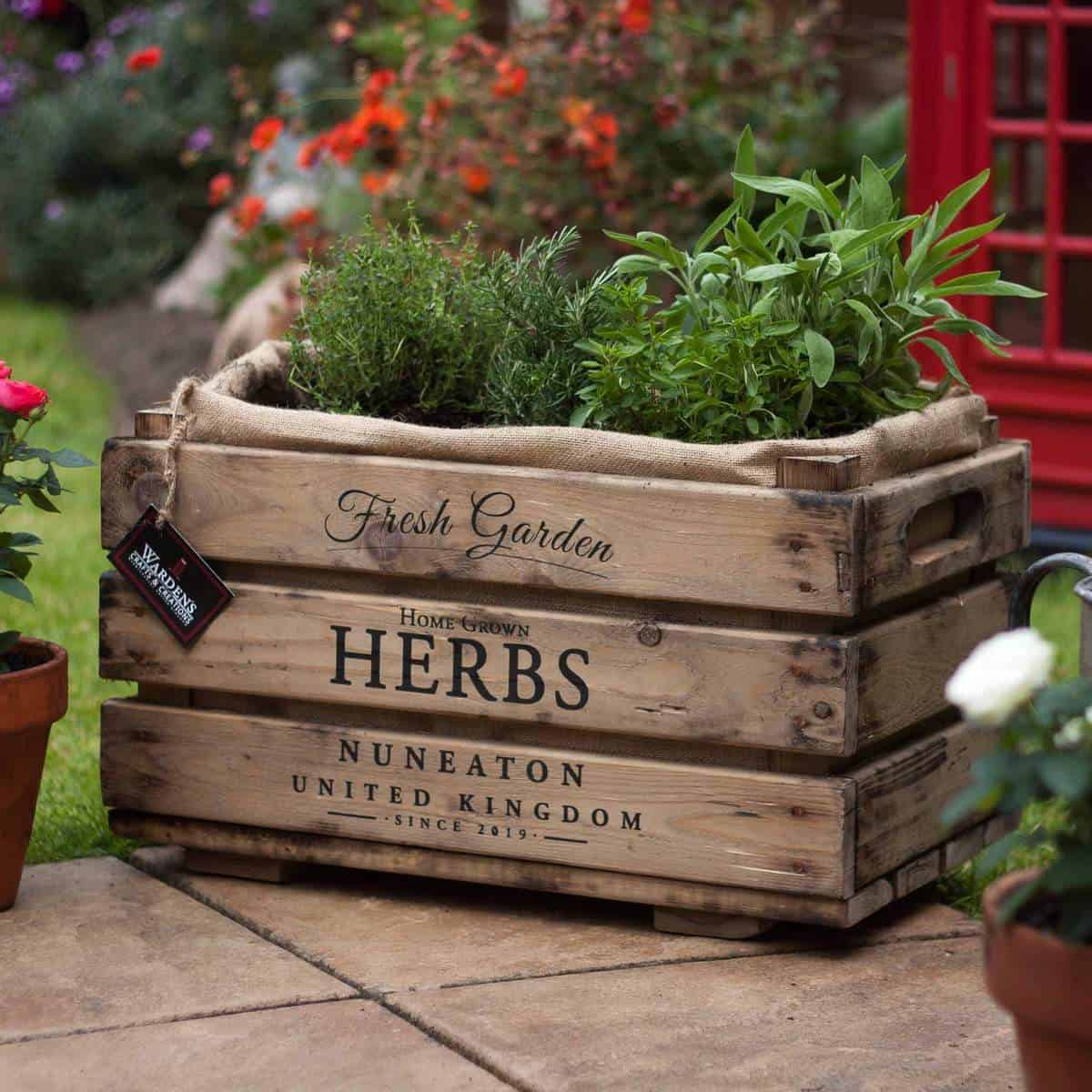When choosing the best wood for your planter box, you’ll need to consider a few things. Think about what you intend to plant in it as well as your local weather conditions. You’ll also need to factor in rot resistance, weight and price.
Everybody’s dream wooden planter box looks magnificent and lasts well without too much maintenance, so what’s the best way to achieve this?

Image credit @planterboxez
What is the best wood for a planter box?
You can’t go wrong with either Cedar or Redwood, which are two of the most popular wood varieties. There are also more affordable choices of timber for wooden planters.
1. Cedar

Cedar is a perfect choice for garden furniture and planters. Credit: Shutterstock
Cedar is a very popular wood. It’s durable, lightweight, crack and rot-resistant. The weight is important if you are lifting planks so keep this in mind if you are making multiple planter boxes.
Cedar tends to fade with exposure to sunlight, turning an attractive grey colour. If you prefer to keep the original shade, see some of the suggestions for coating and dyeing below. Cedar contains natural oils which help to keep it resistant to bugs and fungi that target wood. Cedar is grown in the US, so has to be shipped over to the UK.
2. Cypress
Cypress also produces natural oils, making your planter attractive while also being resistant to insects and fungi. Cypress is lightweight, which may be useful if you are planning to construct a raised planter box.
Scandinavian redwood is usually pressure treated and often used for decking. It’s durable, resistant to rot and long-lasting. This will make an attractive planter, however, it is usually more expensive than some of the other wood available and it may need a sealant to prevent the wood cracking over time.
4. Douglas fir
Douglas Fir is native to the US and is really long-lasting, making it a firm favourite with many buyers. Here in the UK, fir on sale generally comes from Scandinavia.
5. Pine
Pine is a readily available and affordable choice. It is frequently pressure treated which stops rot, but also causes shrinkage long-term so be aware of this when planning sizes and buy extra wood so that you can mend and add pieces later if required. It has an attractive grain and it is lightweight which is important if your planter is located on a balcony. Untreated pine is known to resist shrinking and you can treat it yourself with oil – see more below.
6. Walnut, white oak and black locust
Walnut, white oak and black locust are expensive woods that last a very long time.
7. Mahogany and teak

Credit: Shutterstock
Mahogany and teak are high quality, long-lasting woods that retain their magnificent colour. If you are prepared to spend a bit more, these are excellent options. As these woods aren’t native to the UK, they can be difficult to source.
What is the best wood for planters in the UK?
The best wood to make a planter box in the UK are native trees such as oak and beech, which have been used for centuries to make furniture and in the construction industry. Scots pine is also native to Britain. Walnut and chestnut used to be very popular but are increasingly difficult to source and walnut is expensive.
Gardening centres offer pine and a range of more exotic woods depending on your budget. If you would like to source a locally-grown wood for your planter box, contact a local carpenter or tree surgeon. They can usually offer good advice about local wood suppliers.
The Forest Stewardship Council (FSC) logo on wood reassures buyers that the wood has been grown in environmentally friendly ways. When sourcing wood, try to look beyond the cheapest price and the best quality. Sustainability is an important issue to consider so try to ensure any new wood carries FSC certification. Remember that the best wood for sustainability is probably the wood that grows closest to you.
Also, look for the “Grown in Britain” logo. The benefits are obvious; fewer miles travelled and also a guarantee that no pests or diseases from wood grown in other countries will be present.
Other points to consider when choosing best wood for planters:
- Wood requires regular maintenance to keep its attractive grain and colour and prevent wood rot and pest infestation.
- You may need to sand your wooden planters down every few years and reapply stain, varnish or sealant.
What materials do I need to make a planter box?
- Decide on the size of your planter. Measure the area carefully and then choose your wood.
- You need a saw to cut your wood to size and then assemble your planks on a sheet of plastic or any material so you don’t damage the area where you are constructing.
- Do you need a waterproof liner? Some wood doesn’t, but if you’re growing edible plants, you may want to check whether the wood treatment used is suitable. If not, use a waterproof membrane or architectural fabric which is more environmentally friendly.
- You will also need to ensure good drainage so consider adding sand, pebbles, gravel and other materials.
- You’ll need a selection of tools to assemble your planter box – a saw, a drill, nails or screws, decent gloves and eye protection.
Can I make a planter box out of pine?
Pine offers you an attractive grain for your planter box. Pine is usually treated to ensure its durability and stability in construction so it’s a really good option for an outdoor planter box. Just make sure that is pine from a responsible source and if possible, aim to buy local, FSC wood. If you can find the “Grown in Britain” logo, the pine is probably Scottish.

Pine is a great choice for a DIY planter box. Image credit: @imaginationcreated
What can you grow in your planter box?
1. Decorative flowers
Decorative flowers can grow in any type of wooden planter box. Deeper ones are suitable for plants that need rich, deep soil such as roses and hungry plants which need fertilising regularly.
More on this: What can I plant in a flower box?
2. Succulents
Succulents grow well in planter boxes and they are great for anybody who doesn’t like to do much watering. Some may need to be moved indoors when the temperature drops in the autumn. Lavender will do well growing with these too as they do not need much watering.
3. Edible herbs and flowers
Edible herbs and flowers such as basil, parsley, coriander and chives grow beautifully in planter boxes, but they will need a liner to avoid eating the preservative from the wood. Place these in a sunny area and add some tomatoes as annual plants so you can make tasty salads.
You Might Also Like: 8 Effortless Herb Planter Box Ideas
4. Vegetables and edible fruit
Vegetables, edible fruits like cucumbers and squash, and beans and peas need deep, nutrient-rich soil so make sure your planter box is big enough for plants like these. Line the box well then add good compost, manure if you can, and water frequently. You can add the planter box to a crop rotation plan so you grow potatoes one year, then beans or peas followed by cabbages and so on. Look for seeds that recommend planter box growing too.
FAQs
How do I keep my planter box from rotting?
– Sealants. Untreated wood needs regular maintenance so that it does not leak water, so use a sealant initially and then annually after that.
– Lining. Untreated wood planters can be lined as an alternative to treatment in order to prevent leaks. This lining is also useful for keeping the wood preservative outside your soil.
– Paint can be applied to wooden planter boxes but most people like to see the grain. Any exterior paint can be applied but check if it needs an undercoat first. You may also need to sand it down well before applying paint.
– Pressure-treating pine stops rot, but this also causes shrinkage long-term.
– Stain and varnish. Commercially purchased planters are often varnished or you can apply stain and varnish yourself. If your planter box holds decorative shrubs and non-edible plants, you can use a commercial sealant followed by a preservative for long-lasting protection. This will help your planter to remain functional for 5 years or more.
Take great care when applying these products close to a pond as they can be poisonous to aquatic life.
– Cedar and Teak both contain natural oils which repel water naturally. Some gardeners recommend using larch wood; this timber can be used untreated but it is a specialist wood and difficult to obtain so take advice from your wood supplier on this. Cedar, teak and larch are more expensive than pine, so if your budget is tight, this should be a consideration.
More on this: How to Waterproof A Wooden Planter Box
Are there natural ways to keep my planter box from rotting?
If you want to grow herbs, lettuce, edible fruit, vegetables or flowers or indeed, anything that will go into your mouth, be aware that any commercial varnish you use may end up in your stomach. Makes you think again about what to coat your planter with, doesn’t it?
Alternatives include:
- Natural oils repel water and are not harmful to humans. Examples of these include linseed and hemp oils. They aren’t completely waterproof but water-resistant. Be aware that these two may slightly darken the colour of your wood. Two coats of oil are more effective than one.
- Beeswax is commonly used for wooden household furniture and also on boats for its natural water-resistant qualities. Use liberally by applying with a cloth or sponge. A second coat will improve resistance and repeat annually. It is not heat resistant however and it can still be scratched.
- Teak oil can also be used as protection for your wood planter box. Here’s a detailed analysis of teak oil usage for outdoor furniture
- Liners. Using any of these oils or wax means that you may need to line the inside of your planter as well. This adds extra protection from leaks and helps to prevent the wood from rotting. You can purchase polythene or plastic as a liner in rolls from your DIY shop store.
For a more environmentally friendly method, use landscaping fabric instead of plastic. Worms prefer this and beneficial insects are happier with fabric too.
Can I use pressure-treated pine for a planter box?
It’s fine to use pressure-treated pine for decorative plants but it’s important to consider what you’ll grow in this box, especially if you want to grow food. Read on for pros and cons:
Advantages:
- Pressure-treated pine is very resistant to wood rot and pressure treatment is effective as an insect repellent too.
- The chemical treatment keeps it fairly weatherproof, unlike natural pine which will need a sealant.
Disadvantages:
- The chemical preservative which helps to keep the wood resistant to rot is not really recommended for direct contact with herbs and vegetables for consumption. You will need to line this planter box.
- Another problem with pressure treated wood is that it shrinks over time.
- Pine is a very soft wood that can be scratched and dented easily. It may not be suitable for a busy family or if it’s located near anything which may damage the wood.
Tina’s Tips:
How can I source cheap or recycled wood for garden box planters?
Sourcing old wood which you can saw, chop and fashion into a stunning, planter box is a great option.
- Consider asking friends for old wood leftovers, using any old furniture you no longer have use for or buying offcuts from a local carpenter.
- Many websites offer second-hand sleepers, which make fantastic raised beds and planters.
- Post on local community websites that you need certain amounts of recycled wood.
- Phone recycling companies in your neighbourhood and ask for help. You will be amazed at how many companies are keen to re-use wood in their local community. It saves them money and can be great publicity for the company when local media find out they are helping.
- If your project is a community one, visit a garden website or local garden centre to find out if they can donate plants, compost or seeds. You may need to apply for a grant but it will be worth it as you watch flowers bloom later in the year or pick produce from vegetable plants donated.
You can also use pallets to make a planter box, as well as many other DIY projects.

Save this pin for later






